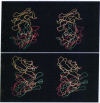Abstract
The structure of an immunoglobulin antigen-binding fragment (Fab) has been thought to be invariantly defined by well-conserved amino acid residues in the variable domains of the heavy and light chains. These conserved residues enable folding of the polypeptide segments into the characteristic immunoglobulin fold domains and are the major controllers of interactions between domains. However, crystallographic studies of some immunoglobulin light-chain dimers have suggested and the crystallographic structure of the Fab in an Fab-neuraminidase complex may have proven that antibodies are not restricted to a single, invariant relative positioning of the two variable domains. We propose that in some cases the detailed quaternary structural relationships between the variable domains of heavy and light chains are not restricted to those of the canonical Fab. It is unclear whether alterations of these relationships occur only after complex formation with antigen or, if in ligand-free solution, Fab conformers might coexist in relative concentrations determined by isomerization rates. In the latter case, antibody-presenting lymphocytes may be polyspecific, and the specificity of lymphocytes might be modulated by anti-idiotopic antibodies complexed to cell surface receptors. In either case, the idiotopic repertoire displayed by an antibody or lymphocyte surface receptor might be changed by the presence or absence of antigen.
Full text
PDF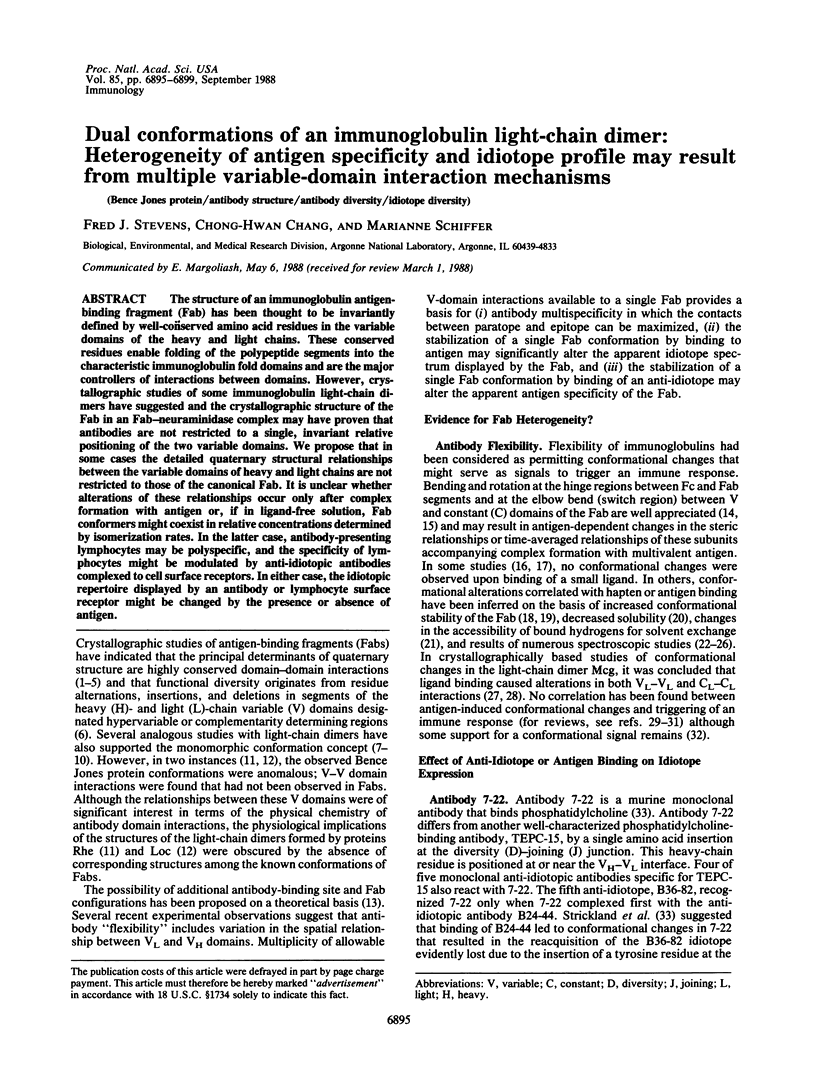
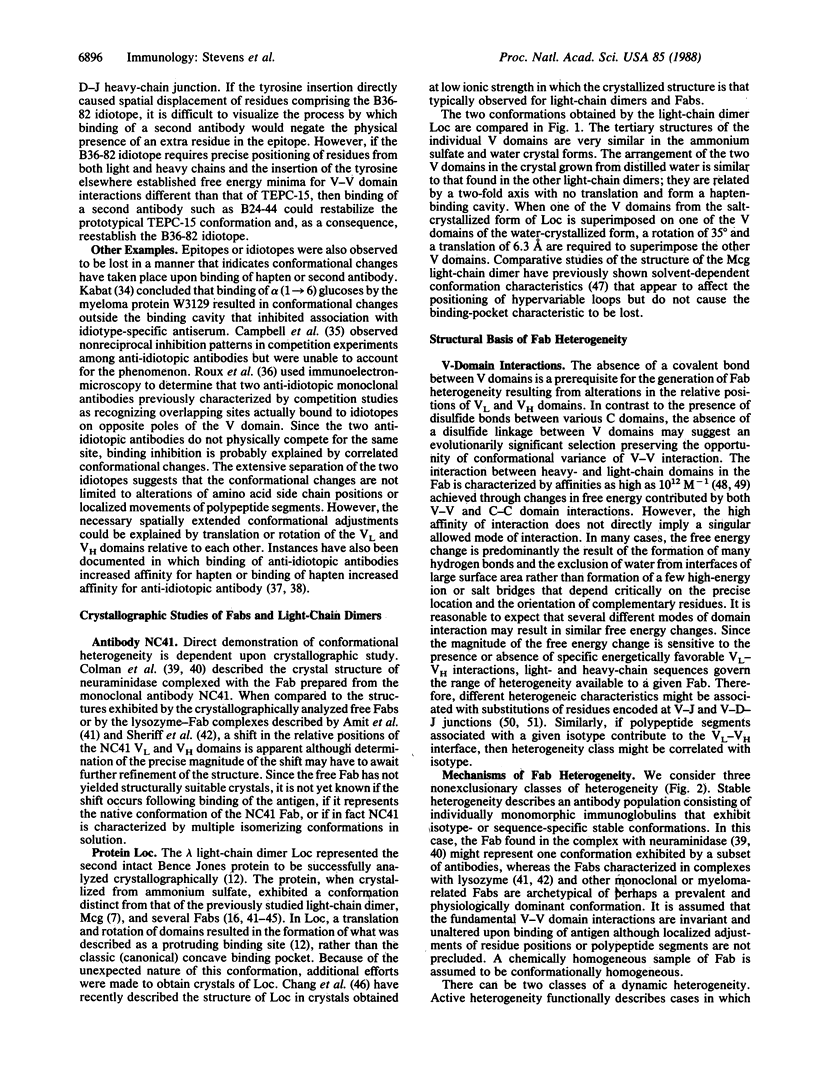

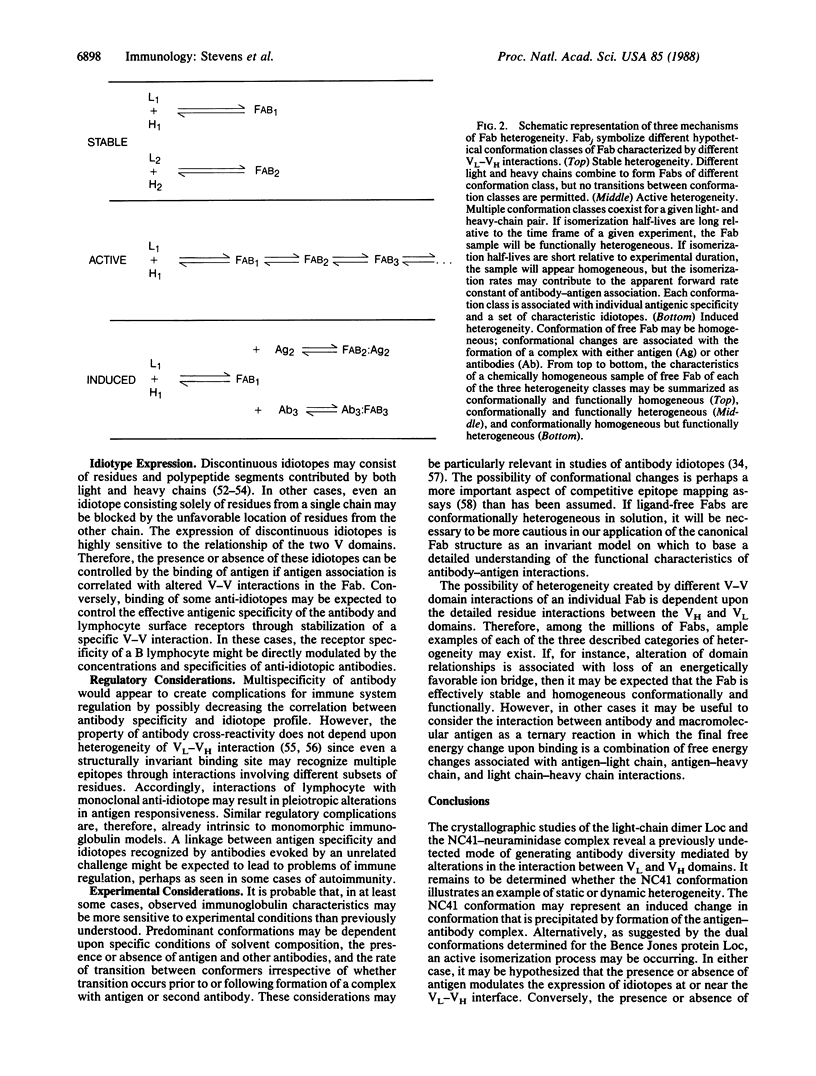
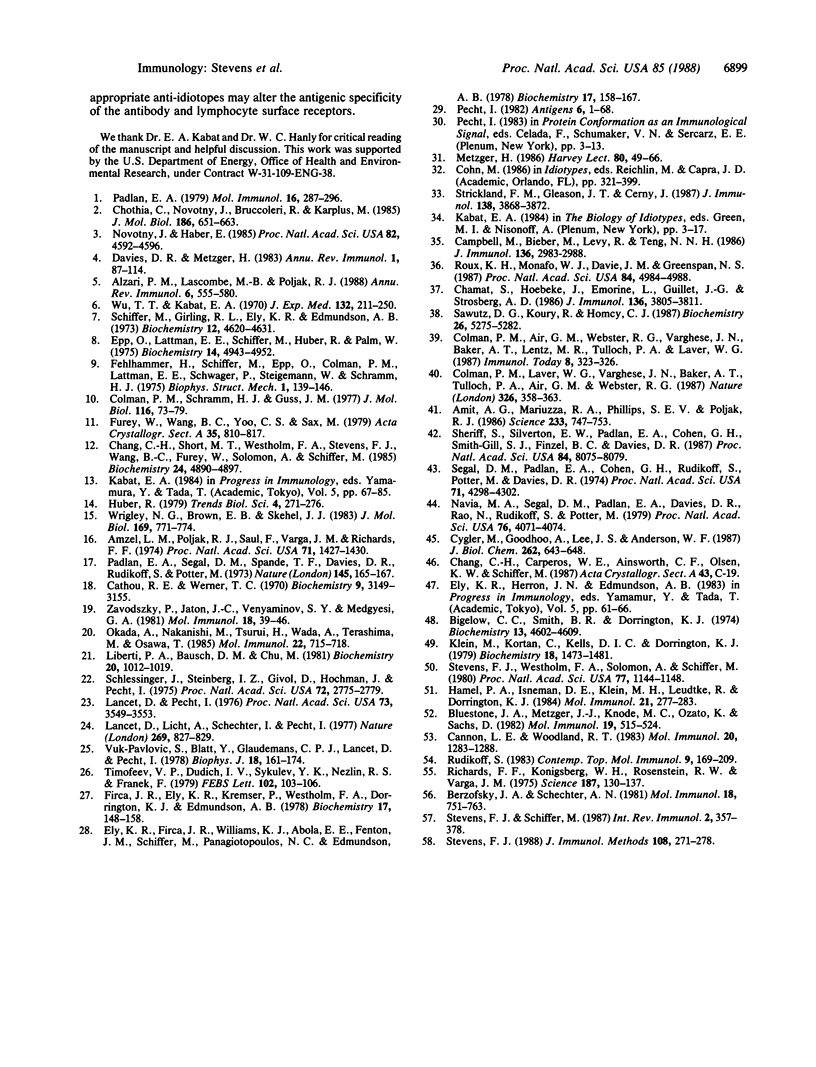
Images in this article
Selected References
These references are in PubMed. This may not be the complete list of references from this article.
- Alzari P. M., Lascombe M. B., Poljak R. J. Three-dimensional structure of antibodies. Annu Rev Immunol. 1988;6:555–580. doi: 10.1146/annurev.iy.06.040188.003011. [DOI] [PubMed] [Google Scholar]
- Amit A. G., Mariuzza R. A., Phillips S. E., Poljak R. J. Three-dimensional structure of an antigen-antibody complex at 2.8 A resolution. Science. 1986 Aug 15;233(4765):747–753. doi: 10.1126/science.2426778. [DOI] [PubMed] [Google Scholar]
- Amzel L. M., Poljak R. J., Saul F., Varga J. M., Richards F. F. The three dimensional structure of a combining region-ligand complex of immunoglobulin NEW at 3.5-A resolution. Proc Natl Acad Sci U S A. 1974 Apr;71(4):1427–1430. doi: 10.1073/pnas.71.4.1427. [DOI] [PMC free article] [PubMed] [Google Scholar]
- Berzofsky J. A., Schechter A. N. The concepts of crossreactivity and specificity in immunology. Mol Immunol. 1981 Aug;18(8):751–763. doi: 10.1016/0161-5890(81)90067-5. [DOI] [PubMed] [Google Scholar]
- Bigelow C. C., Smith B. R., Dorrington K. J. Equilibrium and kinetic aspects of subunit association in immunoglobulin G. Biochemistry. 1974 Oct 22;13(22):4602–4608. doi: 10.1021/bi00719a021. [DOI] [PubMed] [Google Scholar]
- Bluestone J. A., Metzger J. J., Knode M. C., Ozato K., Sachs D. H. Anti-idiotypes to monoclonal anti-H-2 antibodies--I. Contribution of isolated heavy and light chains to idiotype expression. Mol Immunol. 1982 Apr;19(4):515–524. doi: 10.1016/0161-5890(82)90219-x. [DOI] [PubMed] [Google Scholar]
- Campbell M., Bieber M., Levy R., Teng N. N. Influence of avidity and idiotope recognition on the modulation of surface immunoglobulin on malignant human B cells by rat monoclonal anti-idiotype antibodies. J Immunol. 1986 Apr 15;136(8):2983–2988. [PubMed] [Google Scholar]
- Cannon L. E., Woodland R. T. Rapid and sensitive procedure for assigning idiotypic determinants to heavy or light chains: application to idiotopes associated with the major cross-reactive idiotype of A/J anti-phenylarsonate antibodies. Mol Immunol. 1983 Dec;20(12):1283–1288. doi: 10.1016/0161-5890(83)90158-x. [DOI] [PubMed] [Google Scholar]
- Cathou R. E., Werner T. C. Hapten stabilization of antibody conformation. Biochemistry. 1970 Aug 4;9(16):3149–3155. doi: 10.1021/bi00818a006. [DOI] [PubMed] [Google Scholar]
- Chamat S., Hoebeke J., Emorine L., Guillet J. G., Strosberg A. D. The immune response towards beta-adrenergic ligands and their receptors. VI. Idiotypy of monoclonal anti-alprenolol antibodies. J Immunol. 1986 May 15;136(10):3805–3811. [PubMed] [Google Scholar]
- Chang C. H., Short M. T., Westholm F. A., Stevens F. J., Wang B. C., Furey W., Jr, Solomon A., Schiffer M. Novel arrangement of immunoglobulin variable domains: X-ray crystallographic analysis of the lambda-chain dimer Bence-Jones protein Loc. Biochemistry. 1985 Aug 27;24(18):4890–4897. doi: 10.1021/bi00339a025. [DOI] [PubMed] [Google Scholar]
- Chothia C., Novotný J., Bruccoleri R., Karplus M. Domain association in immunoglobulin molecules. The packing of variable domains. J Mol Biol. 1985 Dec 5;186(3):651–663. doi: 10.1016/0022-2836(85)90137-8. [DOI] [PubMed] [Google Scholar]
- Colman P. M., Laver W. G., Varghese J. N., Baker A. T., Tulloch P. A., Air G. M., Webster R. G. Three-dimensional structure of a complex of antibody with influenza virus neuraminidase. 1987 Mar 26-Apr 1Nature. 326(6111):358–363. doi: 10.1038/326358a0. [DOI] [PubMed] [Google Scholar]
- Colman P. M., Schramm H. J., Guss J. M. Crystal and molecular structure of the dimer of variable domains of the Bence-Jones protein ROY. J Mol Biol. 1977 Oct 15;116(1):73–79. doi: 10.1016/0022-2836(77)90119-x. [DOI] [PubMed] [Google Scholar]
- Cygler M., Boodhoo A., Lee J. S., Anderson W. F. Crystallization and structure determination of an autoimmune anti-poly(dT) immunoglobulin Fab fragment at 3.0 A resolution. J Biol Chem. 1987 Jan 15;262(2):643–648. [PubMed] [Google Scholar]
- Davies D. R., Metzger H. Structural basis of antibody function. Annu Rev Immunol. 1983;1:87–117. doi: 10.1146/annurev.iy.01.040183.000511. [DOI] [PubMed] [Google Scholar]
- Ely K. R., Firca J. R., Williams K. J., Abola E. E., Fenton J. M., Schiffer M., Panagiotopoulos N. C., Edmundson A. B. Crystal properties as indicators of conformational changes during ligand binding or interconversion of Mcg light chain isomers. Biochemistry. 1978 Jan 10;17(1):158–167. doi: 10.1021/bi00594a023. [DOI] [PubMed] [Google Scholar]
- Epp O., Lattman E. E., Schiffer M., Huber R., Palm W. The molecular structure of a dimer composed of the variable portions of the Bence-Jones protein REI refined at 2.0-A resolution. Biochemistry. 1975 Nov 4;14(22):4943–4952. doi: 10.1021/bi00693a025. [DOI] [PubMed] [Google Scholar]
- Fehlhammer H., Schiffer M., Epp O., Colman P. M., Lattman E. E., Schwager P., Steigemann W., Schramm H. J. The structure determination of the variable portion of the Bence-Jones protein Au. Biophys Struct Mech. 1975 Feb 19;1(2):139–146. doi: 10.1007/BF00539775. [DOI] [PubMed] [Google Scholar]
- Firca J. R., Ely K. R., Kremser P., Westholm F. A., Dorrington K. J., Edmundson A. B. Interconversion of conformational isomers of light chains in the Mcg immunoglobulins. Biochemistry. 1978 Jan 10;17(1):148–158. doi: 10.1021/bi00594a022. [DOI] [PubMed] [Google Scholar]
- Hamel P. A., Isenman D. E., Klein M. H., Luedtke R., Dorrington K. J. Structural basis for the preferential association of autologous immunoglobulin subunits: role of the J region of the light chain. Mol Immunol. 1984 Apr;21(4):277–283. doi: 10.1016/0161-5890(84)90098-1. [DOI] [PubMed] [Google Scholar]
- Klein M., Kortan C., Kells D. I., Dorrington K. J. Equilibrium and kinetic aspects of the interaction of isolated variable and constant domains of light chain with the Fd' fragment of immunoglobulin G. Biochemistry. 1979 Apr 17;18(8):1473–1481. doi: 10.1021/bi00575a014. [DOI] [PubMed] [Google Scholar]
- Lancet D., Licht A., Schechter I., Pecht I. Hapten-induced allosteric transition in the light chain dimer of an immunoglobulin. Nature. 1977 Oct 27;269(5631):827–829. doi: 10.1038/269827a0. [DOI] [PubMed] [Google Scholar]
- Lancet D., Pecht I. Kinetic evidence for hapten-induced conformational transition in immunoglobin MOPC 460. Proc Natl Acad Sci U S A. 1976 Oct;73(10):3549–3553. doi: 10.1073/pnas.73.10.3549. [DOI] [PMC free article] [PubMed] [Google Scholar]
- Liberti P. A., Bausch D. M., Chu M. Hydrogen exchange analysis of ligand-induced conformational changes in Fab. Biochemistry. 1981 Feb 17;20(4):1012–1019. doi: 10.1021/bi00507a056. [DOI] [PubMed] [Google Scholar]
- Metzger H. Antibodies as effector molecules. Harvey Lect. 1984 1985;80:49–66. [PubMed] [Google Scholar]
- Navia M. A., Segal D. M., Padlan E. A., Davies D. R., Rao N., Rudikoff S., Potter M. Crystal structure of galactan-binding mouse immunoglobulin J539 Fab at 4.5-A resolution. Proc Natl Acad Sci U S A. 1979 Aug;76(8):4071–4074. doi: 10.1073/pnas.76.8.4071. [DOI] [PMC free article] [PubMed] [Google Scholar]
- Okada A., Nakanishi M., Tsurui H., Wada A., Terashima M., Osawa T. A hapten-induced conformational change accompanies the cryoprecipitation of an immunoglobulin. Mol Immunol. 1985 Jun;22(6):715–718. doi: 10.1016/0161-5890(85)90102-6. [DOI] [PubMed] [Google Scholar]
- Padlan E. A. Evaluation of the structural variation among light chain variable domains. Mol Immunol. 1979 May;16(5):287–296. doi: 10.1016/0161-5890(79)90128-7. [DOI] [PubMed] [Google Scholar]
- Padlan E. A., Segal D. M., Spande T. F., Davies D. R., Rudikoff S., Potter M. Structure at 4.5 A resolution of a phosphorylcholine-binding fab. Nat New Biol. 1973 Oct 10;245(145):165–167. doi: 10.1038/newbio245165a0. [DOI] [PubMed] [Google Scholar]
- Richards F. F., Konigsberg W. H., Rosenstein R. W., Varga J. M. On the specificity of antibodies. Science. 1975 Jan 17;187(4172):130–137. doi: 10.1126/science.46122. [DOI] [PubMed] [Google Scholar]
- Roux K. H., Monafo W. J., Davie J. M., Greenspan N. S. Construction of an extended three-dimensional idiotope map by electron microscopic analysis of idiotope-anti-idiotope complexes. Proc Natl Acad Sci U S A. 1987 Jul;84(14):4984–4988. doi: 10.1073/pnas.84.14.4984. [DOI] [PMC free article] [PubMed] [Google Scholar]
- Rudikoff S. Immunoglobulin structure--function correlates: antigen binding and idiotypes. Contemp Top Mol Immunol. 1983;9:169–209. doi: 10.1007/978-1-4684-4517-6_6. [DOI] [PubMed] [Google Scholar]
- Sawutz D. G., Koury R., Homcy C. J. Enhanced antigen-antibody binding affinity mediated by an anti-idiotypic antibody. Biochemistry. 1987 Aug 25;26(17):5275–5282. doi: 10.1021/bi00391a010. [DOI] [PubMed] [Google Scholar]
- Schiffer M., Girling R. L., Ely K. R., Edmundson A. B. Structure of a lambda-type Bence-Jones protein at 3.5-A resolution. Biochemistry. 1973 Nov 6;12(23):4620–4631. doi: 10.1021/bi00747a013. [DOI] [PubMed] [Google Scholar]
- Schlessinger J., Steinberg I. Z., Givol D., Hochman J., Pecht I. Antigen-induced conformational changes in antibodies and their Fab fragments studied by circular polarization of fluorescence. Proc Natl Acad Sci U S A. 1975 Jul;72(7):2775–2779. doi: 10.1073/pnas.72.7.2775. [DOI] [PMC free article] [PubMed] [Google Scholar]
- Segal D. M., Padlan E. A., Cohen G. H., Rudikoff S., Potter M., Davies D. R. The three-dimensional structure of a phosphorylcholine-binding mouse immunoglobulin Fab and the nature of the antigen binding site. Proc Natl Acad Sci U S A. 1974 Nov;71(11):4298–4302. doi: 10.1073/pnas.71.11.4298. [DOI] [PMC free article] [PubMed] [Google Scholar]
- Sheriff S., Silverton E. W., Padlan E. A., Cohen G. H., Smith-Gill S. J., Finzel B. C., Davies D. R. Three-dimensional structure of an antibody-antigen complex. Proc Natl Acad Sci U S A. 1987 Nov;84(22):8075–8079. doi: 10.1073/pnas.84.22.8075. [DOI] [PMC free article] [PubMed] [Google Scholar]
- Stevens F. J., Carperos W. E., Monafo W. J., Greenspan N. S. Size-exclusion HPLC analysis of epitopes. J Immunol Methods. 1988 Apr 6;108(1-2):271–278. doi: 10.1016/0022-1759(88)90429-2. [DOI] [PubMed] [Google Scholar]
- Stevens F. J., Schiffer M. Immunoglobulin structural diversities and idiotypic expression. Int Rev Immunol. 1987 Jul;2(4):357–378. doi: 10.3109/08830188709044762. [DOI] [PubMed] [Google Scholar]
- Stevens F. J., Westholm F. A., Solomon A., Schiffer M. Self-association of human immunoglobulin kappa I light chains: role of the third hypervariable region. Proc Natl Acad Sci U S A. 1980 Feb;77(2):1144–1148. doi: 10.1073/pnas.77.2.1144. [DOI] [PMC free article] [PubMed] [Google Scholar]
- Strickland F. M., Gleason J. T., Cerny J. Reexpression of a T15 idiotope on variant immunoglobulins after the binding of another anti-idiotopic antibody. J Immunol. 1987 Jun 1;138(11):3868–3872. [PubMed] [Google Scholar]
- Timofeev V. P., Dudich I. V., Sykulev Y. K., Nezlin R. S., Franek F. Slow conformational change in anti-dansyl antibody as a consequence of hapten binding: demonstration by ESR spectra. FEBS Lett. 1979 Jun 1;102(1):103–106. doi: 10.1016/0014-5793(79)80938-2. [DOI] [PubMed] [Google Scholar]
- Vuk-Pavlović S., Blatt Y., Glaudemans C. P., Lancet D., Pecht I. Hapten-linked conformational equilibria in immunolglobulins XRPC-24 and J-539 observed by chemical relaxation. Biophys J. 1978 Oct;24(1):161–174. doi: 10.1016/S0006-3495(78)85353-3. [DOI] [PMC free article] [PubMed] [Google Scholar]
- Wrigley N. G., Brown E. B., Skehel J. J. Electron microscopic evidence for the axial rotation and inter-domain flexibility of the Fab regions of immunoglobulin G. J Mol Biol. 1983 Sep 25;169(3):771–774. doi: 10.1016/s0022-2836(83)80170-3. [DOI] [PubMed] [Google Scholar]
- Wu T. T., Kabat E. A. An analysis of the sequences of the variable regions of Bence Jones proteins and myeloma light chains and their implications for antibody complementarity. J Exp Med. 1970 Aug 1;132(2):211–250. doi: 10.1084/jem.132.2.211. [DOI] [PMC free article] [PubMed] [Google Scholar]
- Závodszky P., Jaton J. C., Venyaminov S. Y., Medgyesi G. A. Increase of conformational stability of homogeneous rabbit immunoglobulin G after hapten binding. Mol Immunol. 1981 Jan;18(1):39–46. doi: 10.1016/0161-5890(81)90046-8. [DOI] [PubMed] [Google Scholar]



